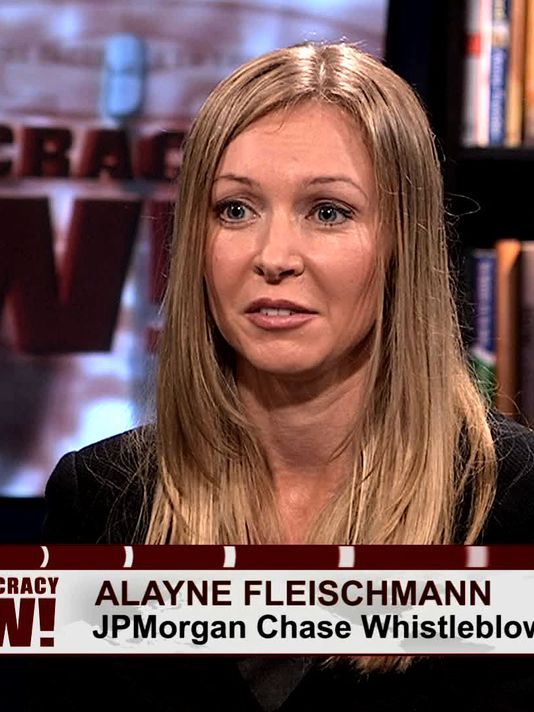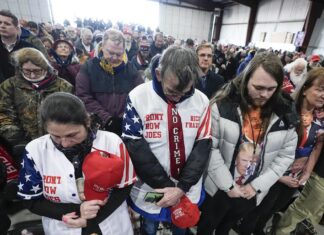NOTE: This web site very rarely publishes articles from other people (this is only the second one), however, this is an exceptional article by author and former JP Morgan Chase executive William D. Cohan who gives a detailed account of how the banks have taken over the U.S. justice system for their own benefit at the expense of individual American taxpayers. This is an important article in U.S. financial history and is even more important as we approach a presidential election. Cohan’s article provides the foundation about why Americans have lost faith both in the financial system and the justice system. It is a rigged game for the wealthy. While the majority of Americans cannot detail how and why this corruption of justice and the corporate takeover of public institutions has happened since the Reagan administration took power in the 1980s, it is now part of the growing populist movement here that is propelling presidential candidates (Bernie Sanders and Trump) and a few intrepid senators ( such as Elizabeth Warren), who accurately describe the current corrupt system accompanied by sincere outrage. This is a must-read article for any professionals in the financial services industry, reporters and concerned investors.
The probes into bank fraud leading up to the financial industry’s crash have been quietly closed. Is this justice?
On May 27, 2015, in her first major prosecutorial act as the new U.S. Attorney General, Loretta Lynch unsealed a 47-count indictment against nine Fédération Internationale de Football Association (FIFA) officials and another five corporate executives. She was passionate about their wrongdoing. “The indictment alleges corruption that is rampant, systemic, and deep-rooted both abroad and here in the United States,” she said. “Today’s action makes clear that this Department of Justice intends to end any such corrupt practices, to root out misconduct, and to bring wrongdoers to justice.”
Lost in the hoopla surrounding the event was a depressing fact. Lynch and her predecessor, Eric Holder, appear to have turned the page on a more relevant vein of wrongdoing: the profligate and dishonest

behavior of Wall Street bankers, traders, and executives in the years leading up to the 2008 financial crisis. How we arrived at a place where Wall Street misdeeds go virtually unpunished while soccer executives in Switzerland get arrested is murky at best. But the legal window for punishing Wall Street bankers for fraudulent actions that contributed to the 2008 crash has just about closed. It seems an apt time to ask: In the biggest picture, what justice has been achieved.
Since 2009, 49 financial institutions have paid various government entities and private plaintiffs nearly $190 billion in fines and settlements, according to an analysis by the investment bank Keefe, Bruyette & Woods. That may seem like a big number, but the money has come from shareholders, not individual bankers. (Settlements were levied on corporations, not specific employees, and paid out as corporate expenses-in some cases, tax-deductible ones.) In early 2014, just weeks after Jamie Dimon, the CEO of JPMorgan Chase, settled out of court with the Justice Department, the bank’s board of directors gave him a 74 percent raise, bringing his salary to $20 million.
(For more on Eric Holder’s pathetic record of prosecuting criminal bankers, see this article on this site.)
The more meaningful number is how many Wall Street executives have gone to jail for playing a part in the crisis. That number is one. (Kareem Serageldin, a senior trader at Credit Suisse, is serving a 30-month sentence for inflating the value of mortgage bonds in his trading portfolio, allowing them to appear more valuable than they really were.) By way of contrast, following the savings-and-loan crisis of the 1980s, more than 1,000 bankers of all stripes were jailed for their transgressions.
At an event at the National Press Club last February, Holder said the virtual absence of convictions (or even prosecutions) this time around did not result from a want of trying. “These are the kinds of cases that people come to the Justice Department to make,” he said. “The inability to make them, at least to this point, has not been as a result of a lack of effort.” Preet Bharara, the U.S. attorney for the Southern District of New York, made a similar argument to me.
The evidence, he said, does not show clear misconduct by individuals. It’s possible that Bharara is correct about that: Wall Street bankers make it their daily business to figure out ways to abide by the letter of the law while violating its spirit. And to be sure, much of the behavior that

led to the crisis involved recklessness and poor judgment, not fraud. But even so, in light of various whistle-blower allegations-and the size of the settlements agreed to by the banks themselves-this explanation strains credulity. The Justice Department’s ethos regarding Wall Street, and the way the department went about its business, appear to be a large part of the story.
Any narrative of how we got to this point has to start with the so-called Holder Doctrine, a June 1999 memorandum written by the then-deputy attorney general warning of the dangers of prosecuting big banks-a variant of the “too big to fail” argument that has since become so familiar. Holder’s memo asserted that “collateral consequences” from prosecutions-including corporate instability or collapse-should be taken into account when deciding whether to prosecute a big financial institution. That sentiment was echoed as late as 2012 by Lanny Breuer, then the head of the Justice Department’s criminal division, who said in a speech at the New York City Bar Association that he felt it was his duty to consider the health of the company, the industry, and the markets in deciding whether or not to file charges
In the aftermath of the crash, the Justice Department did not refrain from prosecutions altogether. In 2009, the U.S. attorney for the Eastern District of New York tried two Bear Stearns hedge-fund managers-Ralph Cioffi and Matthew Tannin-who had effectively run their $1.6 billion fund into the ground in the spring of 2007, an event that many believe was the canary in the coal mine of the financial crisis. But a jury acquitted the two men in November 2009. Added to the general fear that the economy was extraordinarily fragile, the unexpected acquittal seemed to put a deep freeze on Wall Street prosecutions for close to three years.
A serious national investigation of the practices of Wall Street’s pre-crash mortgage-banking activities did not begin in earnest until mid-2012-at least five years after the worst of the bad behavior had occurred-following President Obama’s call to action in the State of the Union address that January and the issuance of subpoenas to Wall Street’s biggest banks. The five-year statute of limitations for ordinary criminal fraud charges had passed while the Justice Department dithered, but civil prosecution of banks and individual bankers, which has a 10-year statute of limitations under a particular banking law, was still a possibility. Holder gave his various U.S. attorneys around the country responsibility for investigating.
A team led by Benjamin Wagner, the U.S. attorney for the Eastern District of California, investigated alleged wrongdoing at JPMorgan Chase, for instance. In many ways,

Wagner’s investigation was typical of the Justice Department’s approach: hoover up hundreds of thousands of pages of e-mails and documents, interview current and former employees about their business practices, and use the findings as a cudgel to extract a financial settlement. Wagner and his team drafted-but did not file-a complaint against the firm in September 2013 that reportedly detailed how JPMorgan Chase itself (not merely Bear Stearns or Washington Mutual, two banks that it bought at the height of the crisis) knowingly packaged shoddy mortgages into securities that did not meet its credit standards and then sold them off to investors.
As part of its investigation, Wagner’s team had deposed Alayne Fleischmann, a JPMorgan Chase banker turned whistle-blower, who’d told the team about what was going on. She had also detailed how, before the crash,

her warnings about continuing to package up the bad mortgages into securities and sell them off as investments had gone unheeded by her superiors. After sharing her concerns with her boss in a 13-page letter, Fleischmann had been marginalized and then fired. (Disclosure: JPMorgan Chase also fired me, as a managing director, in 2004, and I am in litigation with the bank resulting from a soured investment I made in 1999.)
In November 2013, as part of a deal that kept Wagner’s complaint from becoming public-and the specifics of Fleischmann’s revelations from being widely disseminated-JPMorgan Chase agreed to a $13 billion settlement with various federal and state agencies, then the largest of its kind. Holder heralded the settlement as an important moment of accountability for Wall Street.
But extracting large settlements paid with shareholders’ money is not the same as bringing alleged wrongdoers to justice. Instead of presenting a detailed picture of JPMorgan Chase’s misdeeds-as would have happened had Wagner’s complaint been filed and the matter adjudicated in court-the government and the bank negotiated an anodyne 11-page “Statement of Facts” that glossed over many of the details of the behavior Fleischmann was trying to stop, and did not name any JPMorgan Chase bankers.
The Justice Department reached agreements with other Wall Street banks, among them Citigroup and Bank of America, using a similar playbook: Threaten public disclosure of behavior that looks criminal and then, in exchange for keeping it sealed, extract a huge financial settlement. No one individual,

or group of individuals, is held accountable. No predawn raids of Park Avenue apartments are made. No one gets arrested. No one gets publicly shamed.
In February, shortly before Lynch succeeded him, Holder gave federal attorneys and their staffs a deadline: they had 90 days to bring any new prosecutions against individual bankers, traders, or executives on Wall Street before probes against them would be closed. That deadline came and went in May. Lynch, since her elevation, has been largely silent about Wall Street misconduct leading up to the crash; certainly she’s said nothing, in a major public forum, that’s comparable to the zeal and determination she expressed in her statement about bringing FIFA soccer executives to justice. But in fairness, it’s not clear how much she could do anyway: the peak of bad behavior on Wall Street seemed to occur in 2005 and 2006, about 10 years ago, meaning the statute of limitations is just about up. And new cases take time to make.
Holder, meanwhile, along with his old colleague Lanny Breuer, has returned to the white-shoe law firm that he left in order to join the Justice Department-Covington & Burling, which counts among its clients Bank of America, Citigroup, and Wells Fargo. (The firm reportedly kept his office for him.) The sums Holder exacted from Wall Street banks earned him plenty of praise in the media. But without holding real people on Wall Street accountable for their wrongdoing in the years leading up to the financial crisis, the message that their behavior was unacceptable goes undelivered. Instead a very different message is being sent: for financiers, justice is just a check someone else has to write.











